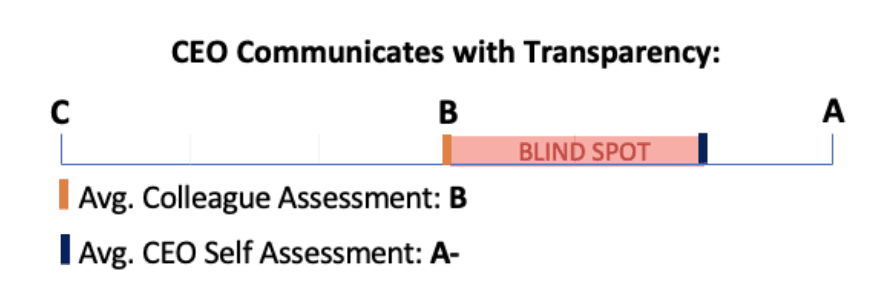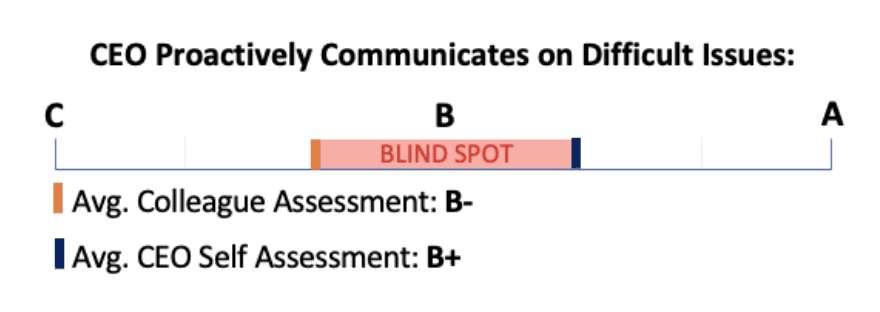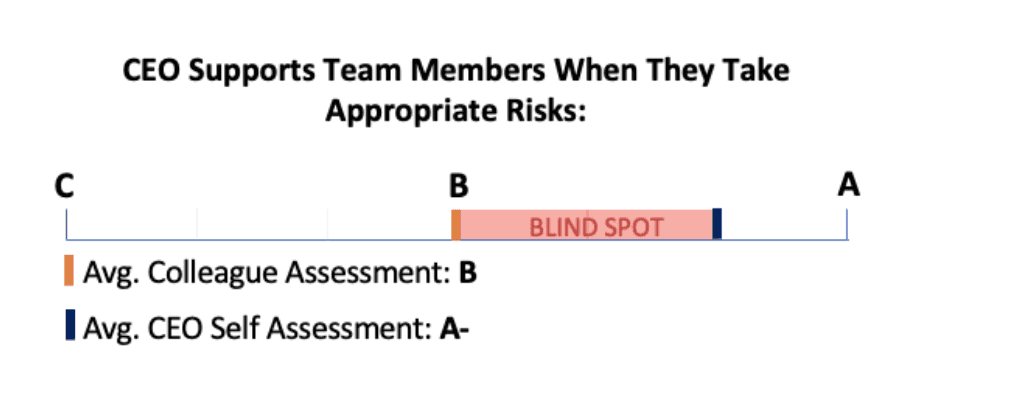
Unseen Hazards: The Top 3 Blind Spots of CEOs
Roster is a leading provider of 360 surveys for small- and mid-market, growth focused CEOs and leadership teams. Roster’s model has been developed and refined after over 20 years of hyper focused research and experience implementing 360 reviews working closely with boards, CEOs, and executive teams. From this, we have harnessed extensive data and can confidently identify critical factors in how great leaders operate and where leaders struggle.
Notably, a few areas emerge as consistent “Blind Spots” for CEOs, reflected in the data by differences in how CEOs perceive their own strengths and weaknesses and how their teams view their competency.
Most C-level executives know they have blind spots, but don’t know what they are, how significant they impact their team, or how best to mitigate those blind spots with other strengths. We have found that the ability to identify Blind Spots (reflecting self-awareness) is critical to an individual’s evolution as a leader and a catalyst to successful performance. Managing those Blind Spots is crucial to overall organizational health; when teams allow blind spots to go unaddressed, that often reflects a weak culture with low trust and cohesion.
So, what are the most common Blind Spots of CEOs?
At Roster, we have conducted 360 reviews evaluating over 70 CEOs of private equity backed organizations and collected self-assessments alongside ratings from their leadership teams and Board members. Across a variety of industries and growth stages, we consistently observe three major CEO Blind Spots, worth exploring:
Transparent Communication
Psychological Safety
Talent Management
Transparent Communication
Transparency is a critical trait for CEOs to practice because it builds trust and fosters alignment and commitment across the organization. Organizations with higher levels of perceived transparency have better employee engagement and retention. Yet CEOs often think they are being transparent when in fact their teams don’t see it that way:


Full transparency by CEOs is rarely possible, and sometimes not optimal. Nevertheless, developing a culture and perception of transparency is essential and will foster trust and healthy teamwork.
For the question, “[CEO] communicates with transparency”, CEOs rate themselves an average score of A- (with 51% giving themselves a perfect score) while their colleagues rate them a B. This question is closely related to another, “[CEO] proactively communicates on difficult issues”, in which CEOs rate themselves an average score of B+ compared to a B- from their colleagues.
How can CEOs work to improve transparency?
a. Set the tone: be forthright, open about issues, and even share some personal vulnerabilities. CEOs who can admit weaknesses, challenges, or mistakes often get stronger overall leadership and communication scores.
b. Use more open modes of communication over private modes as often as is practical; for example, public Slack channels and all-hands meetings. Emails and small-group meetings can lead to information silos or misinterpretation.
c. Involve a wide array of employees when setting policies and making decisions. Transparency means sharing context and information before final decisions have been made. After a decision is made, reinforce the context and rationale.
d. Seek feedback from all corners of the organization. Establish dedicated forums for discussing employee questions and concerns - e.g. Monthly Q+As, regular AMAs (Ask Me Anything), etc. Give these forums attention and energy to ensure they are productive.
e. Share company results (financial and operational) wherever possible, with context and multiple perspectives (e.g. internal, customer, board). Alongside success stories, share failures and how the company responded to those failures.
f. Be honest about confidentiality constraints. When you can’t use full transparency, explain the importance of confidentiality in supporting the goals of the organization.
Psychological Safety
Psychological Safety, or the level of comfort employees feel sharing viewpoints or taking risks with each other, is a key component of high-performing teams. Teams with higher Psychological Safety are more productive and innovative because they are more comfortable learning and experimenting, two activities that drive growth. These teams also do better at addressing issues and resolving conflicts. Once again, CEOs believe they do this well, while their teams often disagree:

For the question, “[CEO] supports team members when they take appropriate risks”, CEOs rate themselves an average score of A- while their colleagues rate them a B.
In addition to supported risk-taking, mutual trust is a foundation of psychological safety. Most CEOs are considered trustworthy, with an average score of A- from their team. However, when it comes to trusting their team, CEOs score much lower, with an average score of B- from their team. CEOs’ self-scores reflect self-awareness and reinforce their lack of trust in the team, scoring themselves a B- as well. This lack of trust helps explain why team members do not feel supported when they take appropriate risks.
How can CEOs work to improve their Psychological Safety scores?
a. Foster a culture of “intellectual honesty”, where the genuine goal is to achieve the right outcome or get to the right answer. That allows people to admit when they are wrong, challenge other logic in the spirit of driving better decisions, and build positive energy as a collective team.
b. Foster healthy dialogue. Practice your dialogue skills: ask open-ended questions, encourage participation, and listen non-defensively. Coach rather than critique.
c. Recognize the two signs that psychological safety has deteriorated – “silence” (avoiding or withdrawing) and “violence” (attacking or controlling) – and reset the environment to encourage different viewpoints without fear of punishment or judgement.
d. Seek out dissenting opinions. If necessary, nominate a “contrarian” in meetings whose job it is to provide alternative perspectives when no one else does.
e. Support experimentation. Adopt a policy of “safe-to-try”, encouraging employees to try new things as long as they do not expose the organization to unacceptable risk.
f. Celebrate when team members take risks. Highlight them at staff or all hands meetings. Whether they are successful or not, describe what was learned in the risk-taking process.
Talent Management:
Organizations and teams are fueled by their top talent, the 20% of employees who produce 80% of the output. In order to retain top talent, these employees must feel that they are being recognized and rewarded for past performance, and that they have adequate coaching to guide them towards an exciting future.
For the question, “[CEO] rewards top performers”, CEOs rate themselves a B+ compared to a B- from peers. And for, “[CEO] is effective at coaching”, CEOs rate themselves a B compared to a C+ from peers.
With Blind Spots on rewarding top performers and coaching, it is not a surprise that when it comes to retaining top performers, CEOs rate themselves a A- compared to a B from peers. In the current environment where talent is more critical (and competitive) than ever, CEOs are well-advised to focus on these factors.
How can CEOs improve their talent management?
a. Work with your HR Leader to build out compelling learning and development programs - a Roster 360 is a valuable investment in the ongoing development and retention of your employees!
b. Engage directly with top performers to understand their ambitions and concerns. Every employee will have different ways of feeling rewarded, and effective talent management requires a custom approach.
c. Increase the frequency of your feedback and performance review cycles so you are surfacing and addressing concerns in near real-time.
d. Develop your skills as a Coach: asking incisive questions, listening, motivating, and providing feedback.
e. Bring in external Coaches to train the people leaders in your organization in Coaching methodologies.
Interested in identifying your unique Blind Spots? Reach out to Roster at sales@roster.com or submit a contact form here for more information on setting up your own 360 Assessment.
This article was written in collaboration with Sam Dailey, an Executive Coach who helps Leadership Teams identify and solve their working issues. Reach out to Sam at his LinkedIn or at samueledailey@gmail.com.
Roster is a leading provider of 360 surveys for small- and mid-market, growth focused CEOs and leadership teams. Roster’s model has been developed and refined after over 20 years of hyper focused research and experience implementing 360 reviews working closely with boards, CEOs, and executive teams. From this, we have harnessed extensive data and can confidently identify critical factors in how great leaders operate and where leaders struggle.
Notably, a few areas emerge as consistent “Blind Spots” for CEOs, reflected in the data by differences in how CEOs perceive their own strengths and weaknesses and how their teams view their competency.
Most C-level executives know they have blind spots, but don’t know what they are, how significant they impact their team, or how best to mitigate those blind spots with other strengths. We have found that the ability to identify Blind Spots (reflecting self-awareness) is critical to an individual’s evolution as a leader and a catalyst to successful performance. Managing those Blind Spots is crucial to overall organizational health; when teams allow blind spots to go unaddressed, that often reflects a weak culture with low trust and cohesion.
So, what are the most common Blind Spots of CEOs?
At Roster, we have conducted 360 reviews evaluating over 70 CEOs of private equity backed organizations and collected self-assessments alongside ratings from their leadership teams and Board members. Across a variety of industries and growth stages, we consistently observe three major CEO Blind Spots, worth exploring:
Transparent Communication
Psychological Safety
Talent Management
Transparent Communication
Transparency is a critical trait for CEOs to practice because it builds trust and fosters alignment and commitment across the organization. Organizations with higher levels of perceived transparency have better employee engagement and retention. Yet CEOs often think they are being transparent when in fact their teams don’t see it that way:


Full transparency by CEOs is rarely possible, and sometimes not optimal. Nevertheless, developing a culture and perception of transparency is essential and will foster trust and healthy teamwork.
For the question, “[CEO] communicates with transparency”, CEOs rate themselves an average score of A- (with 51% giving themselves a perfect score) while their colleagues rate them a B. This question is closely related to another, “[CEO] proactively communicates on difficult issues”, in which CEOs rate themselves an average score of B+ compared to a B- from their colleagues.
How can CEOs work to improve transparency?
a. Set the tone: be forthright, open about issues, and even share some personal vulnerabilities. CEOs who can admit weaknesses, challenges, or mistakes often get stronger overall leadership and communication scores.
b. Use more open modes of communication over private modes as often as is practical; for example, public Slack channels and all-hands meetings. Emails and small-group meetings can lead to information silos or misinterpretation.
c. Involve a wide array of employees when setting policies and making decisions. Transparency means sharing context and information before final decisions have been made. After a decision is made, reinforce the context and rationale.
d. Seek feedback from all corners of the organization. Establish dedicated forums for discussing employee questions and concerns - e.g. Monthly Q+As, regular AMAs (Ask Me Anything), etc. Give these forums attention and energy to ensure they are productive.
e. Share company results (financial and operational) wherever possible, with context and multiple perspectives (e.g. internal, customer, board). Alongside success stories, share failures and how the company responded to those failures.
f. Be honest about confidentiality constraints. When you can’t use full transparency, explain the importance of confidentiality in supporting the goals of the organization.
Psychological Safety
Psychological Safety, or the level of comfort employees feel sharing viewpoints or taking risks with each other, is a key component of high-performing teams. Teams with higher Psychological Safety are more productive and innovative because they are more comfortable learning and experimenting, two activities that drive growth. These teams also do better at addressing issues and resolving conflicts. Once again, CEOs believe they do this well, while their teams often disagree:

For the question, “[CEO] supports team members when they take appropriate risks”, CEOs rate themselves an average score of A- while their colleagues rate them a B.
In addition to supported risk-taking, mutual trust is a foundation of psychological safety. Most CEOs are considered trustworthy, with an average score of A- from their team. However, when it comes to trusting their team, CEOs score much lower, with an average score of B- from their team. CEOs’ self-scores reflect self-awareness and reinforce their lack of trust in the team, scoring themselves a B- as well. This lack of trust helps explain why team members do not feel supported when they take appropriate risks.
How can CEOs work to improve their Psychological Safety scores?
a. Foster a culture of “intellectual honesty”, where the genuine goal is to achieve the right outcome or get to the right answer. That allows people to admit when they are wrong, challenge other logic in the spirit of driving better decisions, and build positive energy as a collective team.
b. Foster healthy dialogue. Practice your dialogue skills: ask open-ended questions, encourage participation, and listen non-defensively. Coach rather than critique.
c. Recognize the two signs that psychological safety has deteriorated – “silence” (avoiding or withdrawing) and “violence” (attacking or controlling) – and reset the environment to encourage different viewpoints without fear of punishment or judgement.
d. Seek out dissenting opinions. If necessary, nominate a “contrarian” in meetings whose job it is to provide alternative perspectives when no one else does.
e. Support experimentation. Adopt a policy of “safe-to-try”, encouraging employees to try new things as long as they do not expose the organization to unacceptable risk.
f. Celebrate when team members take risks. Highlight them at staff or all hands meetings. Whether they are successful or not, describe what was learned in the risk-taking process.
Talent Management:
Organizations and teams are fueled by their top talent, the 20% of employees who produce 80% of the output. In order to retain top talent, these employees must feel that they are being recognized and rewarded for past performance, and that they have adequate coaching to guide them towards an exciting future.
For the question, “[CEO] rewards top performers”, CEOs rate themselves a B+ compared to a B- from peers. And for, “[CEO] is effective at coaching”, CEOs rate themselves a B compared to a C+ from peers.
With Blind Spots on rewarding top performers and coaching, it is not a surprise that when it comes to retaining top performers, CEOs rate themselves a A- compared to a B from peers. In the current environment where talent is more critical (and competitive) than ever, CEOs are well-advised to focus on these factors.
How can CEOs improve their talent management?
a. Work with your HR Leader to build out compelling learning and development programs - a Roster 360 is a valuable investment in the ongoing development and retention of your employees!
b. Engage directly with top performers to understand their ambitions and concerns. Every employee will have different ways of feeling rewarded, and effective talent management requires a custom approach.
c. Increase the frequency of your feedback and performance review cycles so you are surfacing and addressing concerns in near real-time.
d. Develop your skills as a Coach: asking incisive questions, listening, motivating, and providing feedback.
e. Bring in external Coaches to train the people leaders in your organization in Coaching methodologies.
Interested in identifying your unique Blind Spots? Reach out to Roster at sales@roster.com or submit a contact form here for more information on setting up your own 360 Assessment.
This article was written in collaboration with Sam Dailey, an Executive Coach who helps Leadership Teams identify and solve their working issues. Reach out to Sam at his LinkedIn or at samueledailey@gmail.com.
Roster is a leading provider of 360 surveys for small- and mid-market, growth focused CEOs and leadership teams. Roster’s model has been developed and refined after over 20 years of hyper focused research and experience implementing 360 reviews working closely with boards, CEOs, and executive teams. From this, we have harnessed extensive data and can confidently identify critical factors in how great leaders operate and where leaders struggle.
Notably, a few areas emerge as consistent “Blind Spots” for CEOs, reflected in the data by differences in how CEOs perceive their own strengths and weaknesses and how their teams view their competency.
Most C-level executives know they have blind spots, but don’t know what they are, how significant they impact their team, or how best to mitigate those blind spots with other strengths. We have found that the ability to identify Blind Spots (reflecting self-awareness) is critical to an individual’s evolution as a leader and a catalyst to successful performance. Managing those Blind Spots is crucial to overall organizational health; when teams allow blind spots to go unaddressed, that often reflects a weak culture with low trust and cohesion.
So, what are the most common Blind Spots of CEOs?
At Roster, we have conducted 360 reviews evaluating over 70 CEOs of private equity backed organizations and collected self-assessments alongside ratings from their leadership teams and Board members. Across a variety of industries and growth stages, we consistently observe three major CEO Blind Spots, worth exploring:
Transparent Communication
Psychological Safety
Talent Management
Transparent Communication
Transparency is a critical trait for CEOs to practice because it builds trust and fosters alignment and commitment across the organization. Organizations with higher levels of perceived transparency have better employee engagement and retention. Yet CEOs often think they are being transparent when in fact their teams don’t see it that way:


Full transparency by CEOs is rarely possible, and sometimes not optimal. Nevertheless, developing a culture and perception of transparency is essential and will foster trust and healthy teamwork.
For the question, “[CEO] communicates with transparency”, CEOs rate themselves an average score of A- (with 51% giving themselves a perfect score) while their colleagues rate them a B. This question is closely related to another, “[CEO] proactively communicates on difficult issues”, in which CEOs rate themselves an average score of B+ compared to a B- from their colleagues.
How can CEOs work to improve transparency?
a. Set the tone: be forthright, open about issues, and even share some personal vulnerabilities. CEOs who can admit weaknesses, challenges, or mistakes often get stronger overall leadership and communication scores.
b. Use more open modes of communication over private modes as often as is practical; for example, public Slack channels and all-hands meetings. Emails and small-group meetings can lead to information silos or misinterpretation.
c. Involve a wide array of employees when setting policies and making decisions. Transparency means sharing context and information before final decisions have been made. After a decision is made, reinforce the context and rationale.
d. Seek feedback from all corners of the organization. Establish dedicated forums for discussing employee questions and concerns - e.g. Monthly Q+As, regular AMAs (Ask Me Anything), etc. Give these forums attention and energy to ensure they are productive.
e. Share company results (financial and operational) wherever possible, with context and multiple perspectives (e.g. internal, customer, board). Alongside success stories, share failures and how the company responded to those failures.
f. Be honest about confidentiality constraints. When you can’t use full transparency, explain the importance of confidentiality in supporting the goals of the organization.
Psychological Safety
Psychological Safety, or the level of comfort employees feel sharing viewpoints or taking risks with each other, is a key component of high-performing teams. Teams with higher Psychological Safety are more productive and innovative because they are more comfortable learning and experimenting, two activities that drive growth. These teams also do better at addressing issues and resolving conflicts. Once again, CEOs believe they do this well, while their teams often disagree:

For the question, “[CEO] supports team members when they take appropriate risks”, CEOs rate themselves an average score of A- while their colleagues rate them a B.
In addition to supported risk-taking, mutual trust is a foundation of psychological safety. Most CEOs are considered trustworthy, with an average score of A- from their team. However, when it comes to trusting their team, CEOs score much lower, with an average score of B- from their team. CEOs’ self-scores reflect self-awareness and reinforce their lack of trust in the team, scoring themselves a B- as well. This lack of trust helps explain why team members do not feel supported when they take appropriate risks.
How can CEOs work to improve their Psychological Safety scores?
a. Foster a culture of “intellectual honesty”, where the genuine goal is to achieve the right outcome or get to the right answer. That allows people to admit when they are wrong, challenge other logic in the spirit of driving better decisions, and build positive energy as a collective team.
b. Foster healthy dialogue. Practice your dialogue skills: ask open-ended questions, encourage participation, and listen non-defensively. Coach rather than critique.
c. Recognize the two signs that psychological safety has deteriorated – “silence” (avoiding or withdrawing) and “violence” (attacking or controlling) – and reset the environment to encourage different viewpoints without fear of punishment or judgement.
d. Seek out dissenting opinions. If necessary, nominate a “contrarian” in meetings whose job it is to provide alternative perspectives when no one else does.
e. Support experimentation. Adopt a policy of “safe-to-try”, encouraging employees to try new things as long as they do not expose the organization to unacceptable risk.
f. Celebrate when team members take risks. Highlight them at staff or all hands meetings. Whether they are successful or not, describe what was learned in the risk-taking process.
Talent Management:
Organizations and teams are fueled by their top talent, the 20% of employees who produce 80% of the output. In order to retain top talent, these employees must feel that they are being recognized and rewarded for past performance, and that they have adequate coaching to guide them towards an exciting future.
For the question, “[CEO] rewards top performers”, CEOs rate themselves a B+ compared to a B- from peers. And for, “[CEO] is effective at coaching”, CEOs rate themselves a B compared to a C+ from peers.
With Blind Spots on rewarding top performers and coaching, it is not a surprise that when it comes to retaining top performers, CEOs rate themselves a A- compared to a B from peers. In the current environment where talent is more critical (and competitive) than ever, CEOs are well-advised to focus on these factors.
How can CEOs improve their talent management?
a. Work with your HR Leader to build out compelling learning and development programs - a Roster 360 is a valuable investment in the ongoing development and retention of your employees!
b. Engage directly with top performers to understand their ambitions and concerns. Every employee will have different ways of feeling rewarded, and effective talent management requires a custom approach.
c. Increase the frequency of your feedback and performance review cycles so you are surfacing and addressing concerns in near real-time.
d. Develop your skills as a Coach: asking incisive questions, listening, motivating, and providing feedback.
e. Bring in external Coaches to train the people leaders in your organization in Coaching methodologies.
Interested in identifying your unique Blind Spots? Reach out to Roster at sales@roster.com or submit a contact form here for more information on setting up your own 360 Assessment.
This article was written in collaboration with Sam Dailey, an Executive Coach who helps Leadership Teams identify and solve their working issues. Reach out to Sam at his LinkedIn or at samueledailey@gmail.com.